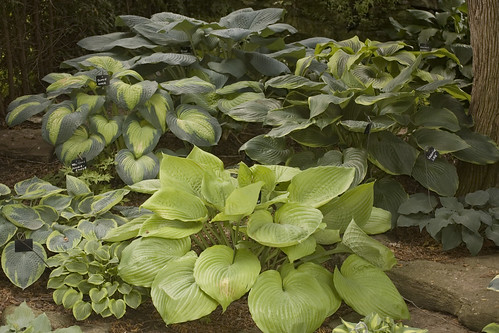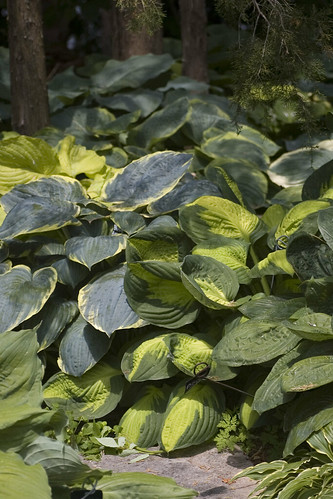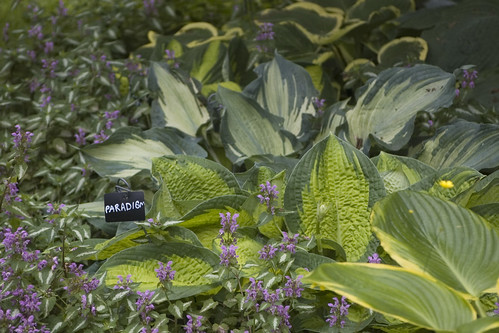
Hosta 'Blue Mammoth' (back), 'Super Nova' (in front of 'Blue Mammoth' on the left), 'Tokudama Flavocircinalis' (front far left), 'Golden Tiara' (front left), 'Sum and Substance' (front center) & 'Valentine Lace' (small one on the right).
Most people know hostas to at least some degree but are often surprised by the huge variety available and occasionally are surprised that they flower (Hosta Plantaginea Grandiflora is one of my favourite hostas even though it only has green leaves - the amazing 5" fragrant flowers in late summer more than make up for it!). With their fantastic range of sizes, colours and even texture as well as tolerance of anything ranging from full sun to full shade (they all do best in full morning sun, afternoon shade - "Shade tolerant, not shade loving") there's probably one that will work for everyone. Sometimes there are many that will work for some people (I have 5 personally and have planted many more around in the landscaping I do - These will be discussed in part 2).
General care for hostas:
Light - Full morning sun is ideal, many can tolerate full sun (yellows can look nicer in sun), some can tolerate full shade (blues and greens do well).
Water - "Evenly moist but well drained" - They don't like drying out but they're not bog plants. Basically average garden conditions will be fine.
Fertilizer - I haven't fertilized mine and they've been fine but I've seen the results when you do fertilize and can't argue with them. Something balanced like a 10-10-10 is supposed to be good. I like slow release granular fertilizers. In general I personally don't fertilize (anything) and they're alright with that.
Potential pests - Snails & slugs mostly, potentially earwigs as well. Supposed to be fairly tasty for deer but fortunately I do not have that problem. Best prevention is to choose resistant varieties though snails and slugs are not overly difficult to deal with and rarely do more than make plants look like crap.
Hardiness - Zones 3-8 - definitely hardy in zone 5.

The only one here I remember the name of is 'Captain Kirk' with the green leaves and gold centers and cupped leaves.
Variations:
Foliage - Colours I've seen in hosta leaves include green, white, yellow and blue You can basically take any of these individually or combined with any two on the center or margin (which can be thin as in albo-marginata or thick as in 'Touch of Class' or 'Striptease') of the leaf and you'll have a plant that already exists. Leaves can also be long and thin ('Hi Ho Silver'), have a wavy margin ('Blue Arrow') - wavy to the point of almost being curled or folded occasionally as in 'Praying Hands', cupped leaves ('Love Pat'), bullated leaves ('Captain Kirk'), round leaves ('Golden Tiara'). Foliage can be upright ('Krossa Regal') or more mounding ('Blue Angel').
Flowers - Generally about an inch to two inches and white to dark lavender and generally flower in July though some are much larger and fragrant and flower later in the summer (I've only seen these in white). I've seen pictures of some double flowered hostas but never seen one in person. Other colours are being worked on as well.
Size - from minuscule ('Mouse Ears', 'Holy Mouse Ears') to huge ('Sum and Substance', 'Blue Mammoth').

Front to back - unknown hosta with smooth green leaves with a thin yellow margin, 'Paradigm' with bullated leaves, green with a moderately thick blue edge, & 'Guardian Angel' with smooth leaves, wavy edge variegated with what looks to me like a dark blue edge lighter blue center.
Next post will deal with a few selected varieties I want to go into more detail about including (as long as the weather's dry enough I can get pictures) the varieties I grow as well as some more from Limestone Gardens.


No comments:
Post a Comment